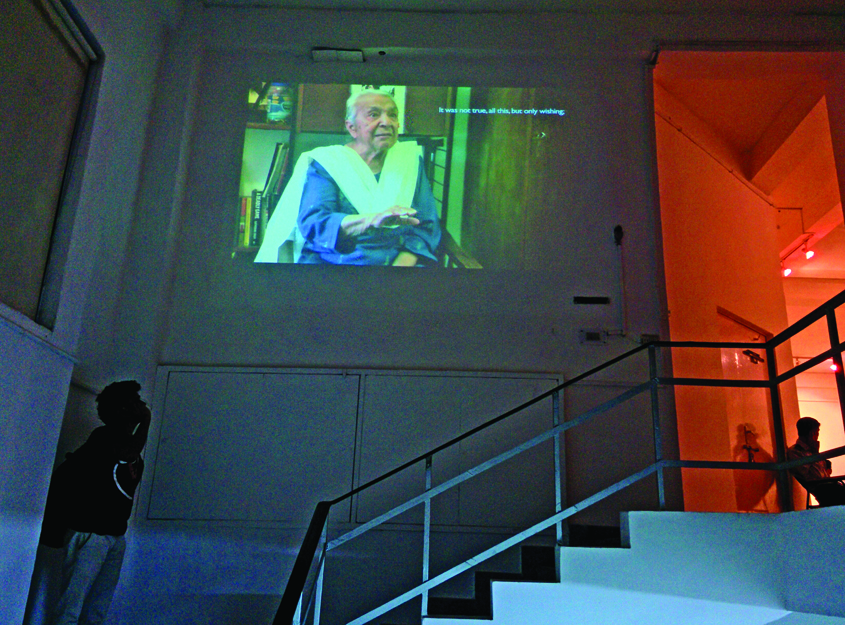Crossing the main gate, as you begin to climb the stairs towards the exhibition, you see the projection of the late actress and dancer Zohra Sehgal reciting a poem. “Mujh se pehli si muhabbat mere mehboob na maang/ Maine samjha tha ke tu hai to darakhshaan hai hayaat.
[Oh my love don’t ask me for the love I once gave you/I thought that life will shine eternally one me only if I had you],” says Zohra. The poem is by Faiz Ahmad Faiz written in 1943. The video is extracted from the documentary Zohra Segal on Zohra Segal, 2012, made by Anant and M.K. Raina.

The show has emerged from three concepts — the 17th century marble wonder, the Taj Mahal, made at the order of emperor Shah Jahan. Poet-lyricist Sahir Ludhianvi’s response to the Taj and, retired postmaster general Saidul Hasan Qadri’s Maqbara Yaadgare Mohabbat; a “replica” of the Taj currently under construction. Along with this, the exhibition also looks at the outcome of what happens when these three concepts intermingle.
There is the complicated presence of devotional love in the exhibition when you encounter an empty pedestal covered by a yellow fabric which gets its colour from recycled marigold flowers that were given as offerings at Mumbai’s Siddhivinayak temple. The fabric is from The Temple Project initiated by Adiv Pure Nature, an organisation which aims to propagate the use of natural dyes on textiles.
Dang’s format caught our attention because the exhibition would unfold as a series of ‘happenings’ besides the works in the gallery.”
There is also the presence of public affection for Taj when you see a boxful of fake currency, an artwork titled My India Affair by Mexican artist Lorena Herrera Rashid. This opposes the increased prices of the Taj. Backpacking across India in 2001, Rashid got involved in the protests and eventually staged an intervention in support of the protestors at an award ceremony.
Gitanjali Dang, the curator of the show talks to Guardian 20 about the show. She says, “This is the second and expanded iteration of the exhibition. The first happened in Mumbai in 2014. The show looks at ideas of love, power, access etc from multiple points of view.” Dang also runs Khanabadosh arts lab in Mumbai since 2012.

The exhibition also looks at unconditional love. There are photographs which convey the story of Saidul Hasan Qadri and his wife the late Tajammuli Begum. In Kaser Kalan which is a village in Dibai tehsil approximately 150km from Delhi, Qadri has began work on a maqbara in the memory of his wife. The couple was childless and Begum was apprehensive that no one will be visiting their graves. Sensing her fear, Qadri promised her a mausoleum that would bring people to their graves. The mausoleum is quite similar to the original Taj Mahal. The work on the maqbara is currently on hold as Qadri has already spent his life savings, i.e. Rs 10 lakh, on its construction. He turns 80 this year.
One can also see little drawings on the wall by artist Gagan Singh. Talking about the exhibition, he says, “I think moments when you feel love, experience love or share an intimate moment, it accounts for what could be love in the capital.” Dang tells how the works by Gagan came about. “Gagan has been working in the space for almost a month in advance. He has been visiting the gallery and responding to encounters such as those taking place at the site — i.e. he’s been sitting in lectures and walking around the campus etc. As such, the exhibition has been shaped around Gagan’s mark making,” says Dang.
Shukla Sawant, professor, Visual Studies, SAA, JNU, shares the reason the artworks found space at the SAA. She says, “Dang’s format caught our attention because the exhibition would unfold as a series of ‘happenings’ besides the works in the gallery. The stress on the ephemeral and contingent rather than objects made the curatorial project interesting.”
The show goes on till 15 November at SAA Auditorium, JNU, Delhi

